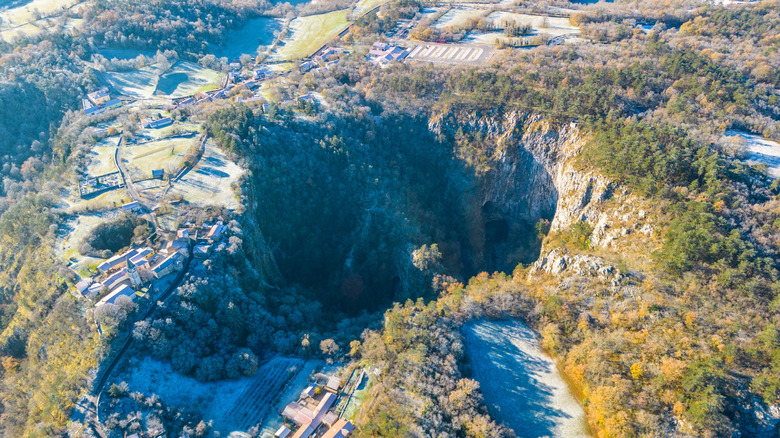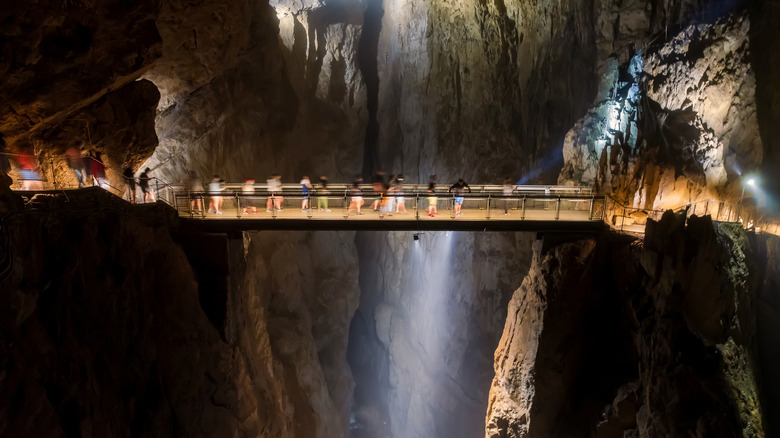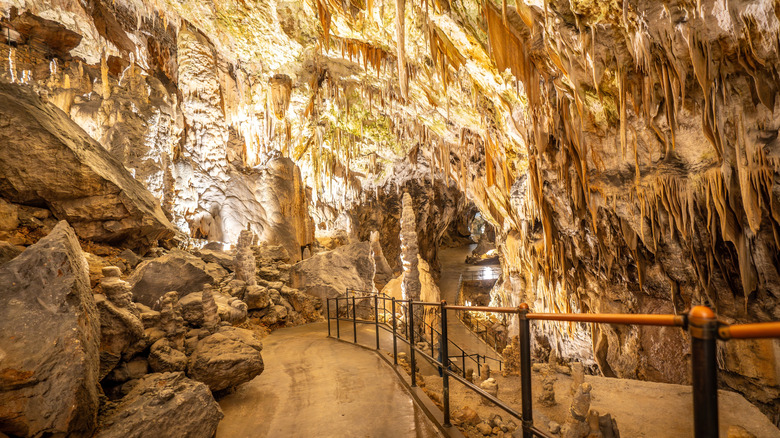Rick Steves' Favorite Underground Cave System Is A Captivating Gem Hidden In Slovenia
In a world where we can examine just about every part of the planet's surface with Google Maps, it sometimes feels like there is very little mystery and adventure left on Earth. There are some remote, unexplored places and mountains yet to be conquered but, by and large, the next frontiers of discovery lie below the surface at the bottom of our oceans and cave systems. The latter can inspire awe and dread in equal measure, and the world's deepest caves can also be the most dangerous. But it isn't necessary to take your life in your hands to get a taste of the world's subterranean wonders. Don't just take our word for it; Rick Steves' favorite cave system is a hidden gem tucked away in Slovenia.
Since the dissolution of the former Eastern Bloc and the subsequent break-up of Yugoslavia in 1992, Slovenia doesn't draw the attention of tourists like the rugged coast of Croatia or the city-break treasures of Prague, Budapest, or Krakow. That's a pity because this lesser-visited European nation has plenty to offer, ranging from its laid-back capital, Ljubljana, to the picture-postcard beauty of Lake Bled. Slovenia is at the eastern end of the Julian Alps, and it is a hilly part of Europe, with over 300 mountains taller than 6,500 feet and more than 50 ski resorts. Almost half the country sits on karst (porous limestone), which means the ground beneath is riddled with around 14,000 caves. And the most spectacular of all is Rick Steves' pick, the Škocjan Caves.
What is so special about the Škocjan Caves?
Rick Steves regards Slovenia as Europe's best-kept secret, which makes the Škocjan Caves a hidden gem within a hidden gem. Located near the Italian border about an hour's drive from Ljubljana, the system was added to UNESCO's list of World Heritage Sites in 1986. Over three miles of caverns, tunnels, and grottoes have been explored so far, and the Reka River flows into the cave and runs underground for more than 20 miles.
A fully guided tour lasting 90 minutes provides visitors with an unforgettable subterranean adventure, winding through the Silent Cave with its towering stalagmites and stalactites before reaching the jaw-dropping spectacle of the Murmuring Cave. With the swirling waters of the river below, it is one of the largest underground canyons in Europe. Steves is suitably impressed by its dimensions (per his website): "It's a world where a thousand evil 'Wizard of Oz' monkeys could comfortably fly in formation."
A hair-raising highlight is crossing a 150-foot bridge spanning a wide crevasse before the tour ends with another breathtaking sight. The tunnels open out into the dual abyss of Velika dolina (Big Collapse Dolene) and Mala dolina, formed in prehistoric times when the roof of a vast cave collapsed. Then, all that remains is a steep ascent back into daylight, and maybe grab a bite while you reflect on the splendor of the caves at nearby Ambrožič Restaurant.
Rick Steves' other Slovenian cave pick
Rick Steves advises that while the Škocjan Caves are his favorite, nearby Postojna Cave is Slovenia's most popular tourist attraction. Around a 20-minute drive from Škocjan, the Postojna Cave Park website pitches the spectacle as "the world's most captivating cave." That's for you to decide, but there's little denying that a trip here is a whole lot of fun. The tour begins with a two-mile journey into the heart of the caves on a brightly-colored toyland train before the well-paved walkways lead you through a series of beautifully lit galleries full of outlandish formations. Steves describes the experience (per his website): "A bridge over a canyon takes you into 'Spaghetti Hall,' named for the long, skinny stalactites that seem to be dripping from the ceiling. After passing some huge, white, melting-ice-cream formations, you wind up in the impressively vast cavern called the 'Concert Hall.'"
Along the way, you might spot some of Postojna's unusual residents: Olms, or strange flesh-colored salamanders endemic to the cave systems of Slovenia's Dinaric karst. Nicknamed "Baby Dragons," the first written accounts of these peculiar creatures date back to the 17th Century when locals thought they were the offspring of a far larger monster lurking in the depths. Steves suggests that while Postojna doesn't have Škocjan's big finale, the formations found here are more diverse and colorful. The close proximity of both caves means that you don't have to miss out on either, and they make for an unforgettable underground adventure during your trip to the country.


